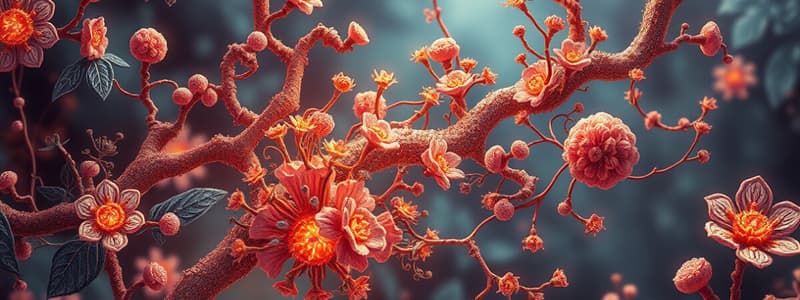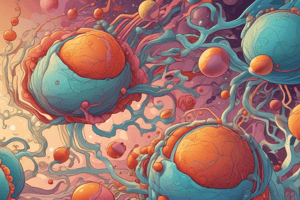Podcast
Questions and Answers
What is biochemistry?
What is biochemistry?
- The study of chemical reactions in plants
- A discipline in biochemistry; is the description of molecules in biology/chemistry of proteins (correct)
- The study of molecules in biology
- A discipline in chemistry
What is molecular biology?
What is molecular biology?
A discipline in biochemistry; the manipulation of DNA, genetics.
What does cell biology study?
What does cell biology study?
A discipline in biochemistry; larger scale, functions and mechanisms within a cell/cell energetics.
What is cellulose?
What is cellulose?
What is glycogen?
What is glycogen?
What is a protein?
What is a protein?
What does nucleotide refer to?
What does nucleotide refer to?
What are the chemical elements commonly found in biochemistry?
What are the chemical elements commonly found in biochemistry?
What is the significance of carbon in biochemistry?
What is the significance of carbon in biochemistry?
What is a covalent bond?
What is a covalent bond?
What characterizes a non-covalent bond?
What characterizes a non-covalent bond?
Match the following types of non-covalent interactions:
Match the following types of non-covalent interactions:
The H bond _____ becomes more tightly linked, the H bond _____ becomes less tightly linked.
The H bond _____ becomes more tightly linked, the H bond _____ becomes less tightly linked.
What types of non-covalent interactions are there?
What types of non-covalent interactions are there?
What role does water play in biological systems?
What role does water play in biological systems?
What is the ideal temperature of water with the highest heat capacity?
What is the ideal temperature of water with the highest heat capacity?
What is the pH of blood?
What is the pH of blood?
Which of the following statements about amino acids is true?
Which of the following statements about amino acids is true?
What is the function of peptidases?
What is the function of peptidases?
Define hydrolysis in the context of amino acids.
Define hydrolysis in the context of amino acids.
What is SDS?
What is SDS?
What is a gel used to determine the molecular size and purity of a protein?
What is a gel used to determine the molecular size and purity of a protein?
Flashcards are hidden until you start studying
Study Notes
Biochemistry Fundamentals
- Biochemistry: Study of biological and chemical molecules, primarily proteins.
- Molecular Biology: Focuses on DNA manipulation and genetics.
- Cell Biology: Examines functions and mechanisms within cells.
Natural Polymers
- Cellulose: Found in plants, critical for structural storage.
- Glycogen: Storage form of energy in animals.
- Proteins: Comprised of tightly linked peptide bonds.
- Nucleotides: Building blocks of nucleic acids, linked by covalent bonds.
Chemical Elements in Biochemistry
- Common elements: Carbon (C), Hydrogen (H), Nitrogen (N), Oxygen (O), Sulfur (S).
- Carbon: Forms strong single or double bonds, allows for structural complexity.
Chemical Bonds
- Covalent Bonds: Strong bonds formed by sharing electron pairs between atoms, allowing flexibility.
- Non-Covalent Bonds: Weaker, transient interactions crucial for molecular recognition, include:
- Electrostatic interactions (ionic bonds)
- Hydrogen bonds
- Van der Waals forces
- Hydrophobic interactions
Non-Covalent Interactions
- Electrostatic Interaction: Ionic connections like Na⁺ and Cl⁻ in NaCl.
- Hydrogen Bonds: Form when H is shared between electronegative atoms (N, O, F).
- Van Der Waals Forces: Temporary dipole-based interactions; weak but contribute cumulatively.
- Hydrophobic Interaction: Non-polar molecules clustering in polar environments, e.g., water.
Water in Biochemistry
- Acts as a biological solvent, dissolving many organic and biological materials.
- In reactions, it participates in bond cleavage.
- Critical for temperature and pH regulation; optimal at 37°C.
- Hydrophilic substances bond via dipole-dipole and hydrogen bonding.
- Hydrophobic aliphatic compounds lack affinity for water, typically consist of long chains of C and H.
Acid-Base Chemistry
- pH: Measures hydrogen ion concentration, calculated as -log[H⁺].
- Acids release protons, while bases accept protons.
- Ka & pKa: Reflect acidity, with pKa = -log[Ka].
- Monoprotic Acids: Release one proton; polyprotic acids release multiple.
- Buffer Solutions: Resist changes in pH, crucial for biochemical stability (e.g., acetate, citrate, phosphate).
Amino Acids
- Composed of amino, carboxyl, alpha carbon, and R-group.
- Chirality: Alpha carbon binds four different groups, yielding enantiomers.
- Commonly known forms of amino acids are L (notable for biological processes).
- Isoelectric pH: pH at which an amino acid has no net charge, calculated from average pKa values.
Protein Structure and Composition
- Peptides and Proteins:
- 1-10 amino acids = multiple
- 10-100 amino acids = polypeptide
-
100 amino acids = protein.
- Protein Composition:
- Monomeric: Single polypeptide chain.
- Multisubunit: Multiple polypeptide chains (oligomeric).
- Simple: Only made of amino acids; Conjugated: includes non-amino acid components.
- Globular vs Fibrous Proteins: Globular proteins are soluble in water, while fibrous proteins contribute to structural integrity.
Protein Purification Techniques
- Assay Development: Initial step in purification process.
- Fractional Centrifugation: Separates supernatant (liquid) from pellet (solid).
- Chromatography Methods: Such as:
- Gel Filtration: Based on size; larger proteins elute first.
- Ionic Exchange: Separates by charge, utilizing agarose or cellulose.
- Affinity Chromatography: Based on ligand interactions.
Molecular Weight and Analysis
- Specific Activity: Ratio of total activity to total protein; helps in assessing enzyme concentration.
- Yield: Total activity during the process over original activity.
- Purification Level: Measures the effectiveness of purification based on specific activity.
Gel Electrophoresis
- SDS-PAGE: Assesses molecular size and purity; smaller proteins migrate faster.
- Sodium Dodecyl Sulfate (SDS): Anionic detergent used to coat proteins.
- Polyacrylamide Gel (PAGE): Used in size and purity assays; contains acrylamide, a neurotoxic component that forms pore structures.
Summary of Key Characters and Processes
- Cysteine & Cystine: Cysteine is reduced; cystine features oxidized disulfide bonds.
- Condensation and Hydrolysis Reactions: Join or split amino acids, respectively.
- Peptidases: Proteins that cleave peptide bonds (e.g., trypsin).
- Reducing Agents: Such as beta-mercaptoethanol, break disulfide bonds.
Essential Terminology
- Residue: Refers to the side chain of an amino acid; directionality denoted as left (N-terminus) and right (C-terminus).
- Isoelectronic Point: pH where net charge of an amino acid is neutral; average of pKa values.
Studying That Suits You
Use AI to generate personalized quizzes and flashcards to suit your learning preferences.




